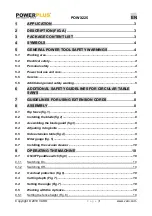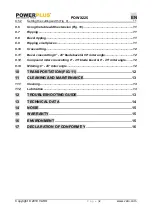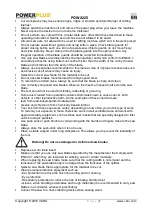
POWX225
EN
Copyright © 2019 VARO
P a g e
|
6
www.varo.com
▪
Check the extension cables regularly and replace them when they are damaged.
▪
Keep the handles dry, clean and free of oil and grease.
▪
Remove the plug from the socket when the power tool is not in use, before maintenance
and when changing tools such as saw blades, drill bits, cutters.
▪
Check the power tool for possible damage.
▪
Before further use of the power tool, check carefully that guards or slightly damaged parts
are functioning correctly and properly.
▪
Check that the movable parts are functioning properly and that they do not jam and are
not damaged. All parts must be mounted correctly and comply with all conditions in order
to ensure correct operation of the power tool. Damaged guards and parts must be
repaired or replaced in accordance with their intended use by a recognised workshop,
unless otherwise specified in the operating instructions.
▪
Damaged switches must be replaced at a customer service shop.
WARNING! The use of other insertion tools and other accessories may
involve a risk of personal injury.
▪
This power tool complies with the relevant safety regulations. Repairs may only be carried
out by a qualified electrician using original spare parts; otherwise there is a risk of
accidents for the user.
▪
Secure the workpiece. Use clamping devices or a vice to fix the workpiece. Thus it will be
held more securely than by hand.
▪
Protect the cable from heat, oil and sharp edges.
▪
Unplug the power tool before any adjustment, maintenance or repair.
6 ADDITIONAL SAFETY GUIDELINES FOR CIRCULAR TABLE SAWS
▪
Replace insert when worn.
▪
Wear gloves when handling saw blades and rough material. Saw blades shall be carried in
a holder whenever practicable.
▪
Faults in the machine, including guards or saw blades, should be reported as soon as they
are discovered.
▪
No other people are allowed to stand in the direct vicinity of the machine when it is in use.
People not operating the machine must maintain a suitable safe distance!
▪
Never lay the power cable over the machine table!
▪
Use the push rod to pass the work piece safely into the saw blade! Do not come too close
to the saw blade!
▪
Make sure that the thickness of the material to be cut is less than the maximum possible
cutting depth.
▪
Never cut “hands-free”! The work piece must always lie level on the machine table and be
moved along the stop! The work piece must always be pressed hard against the stop!
▪
Never cut work pieces that are so small that they cannot be safety pressed against the
stop and could turn!
▪
Never cut work pieces that are so small that they cannot be moved by the push rod at a
safe distance from the saw blade!
▪
Only cut one work piece at a time! Never cut several work pieces simultaneously! Work
piece are not allowed to be placed behind or on top of each other!
▪
There is a danger of the work piece “jamming” and slipping away!
▪
Make sure that the work piece cannot slip while cutting or get jammed in the saw blade!
▪
Clean the working area and the work piece after each cut.
▪
Never reach into the openings of the device! Never insert objects into the openings of the
device (e.g. the saw blade casing, dust extraction adaptor). Danger of cuts!
▪
Never remove the cutting piece if the machine is still switched on or running! Danger of
cutting yourself!


































